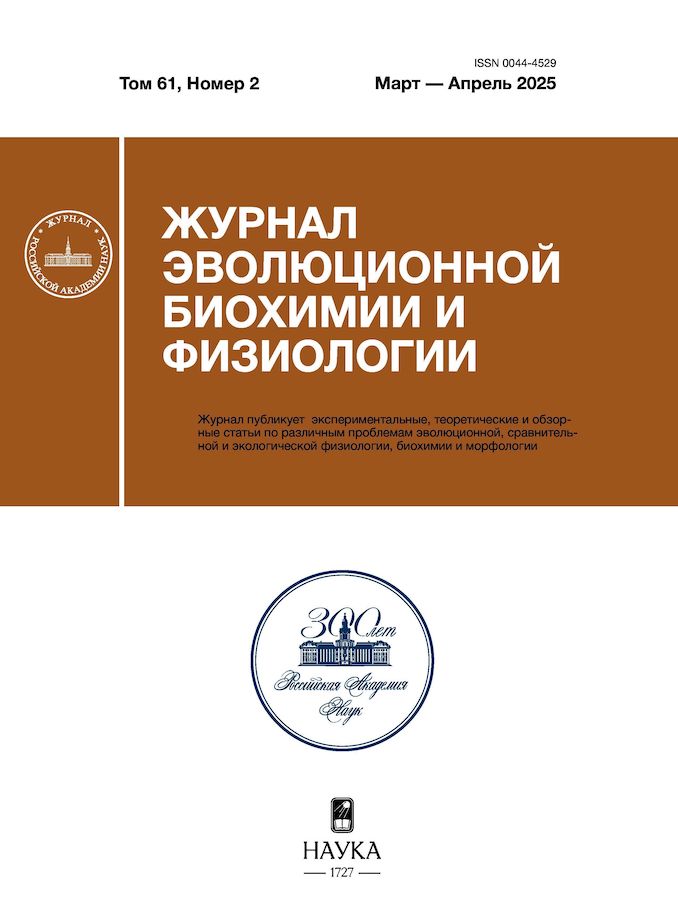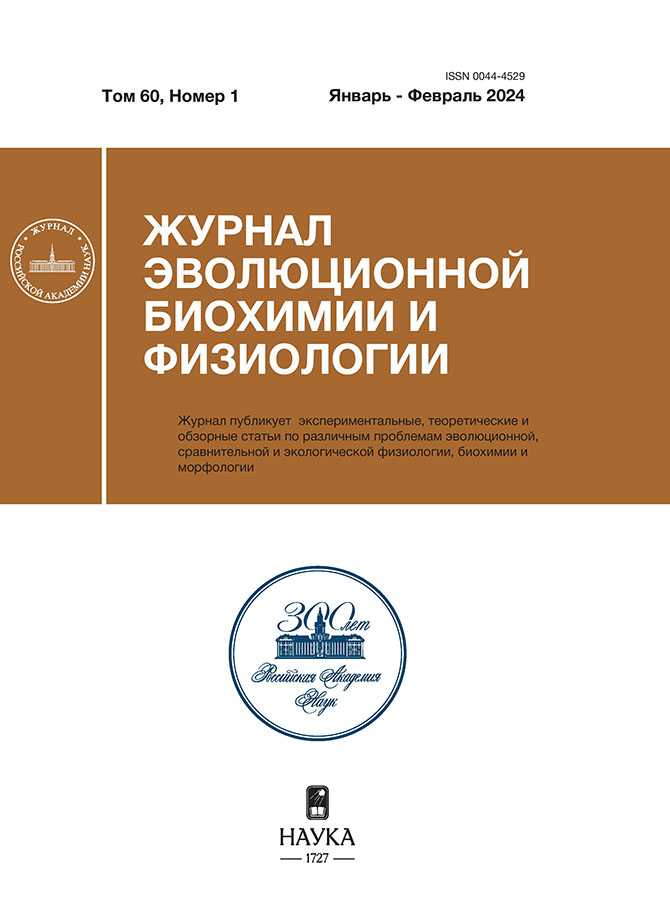Роль опорной афферентации в формировании мышечных синергий при локомоциях
- Авторы: Моисеев С.А.1
-
Учреждения:
- Великолукская государственная академия физической культуры и спорта
- Выпуск: Том 60, № 1 (2024)
- Страницы: 149-159
- Раздел: ЭКСПЕРИМЕНТАЛЬНЫЕ СТАТЬИ
- URL: https://cijournal.ru/0044-4529/article/view/648118
- DOI: https://doi.org/10.31857/S0044452924010111
- EDN: https://elibrary.ru/ZETQUD
- ID: 648118
Цитировать
Полный текст
Аннотация
Изучали особенности формирования мышечных синергий при выполнении локомоций в условиях полной и частичной разгрузки веса тела. Извлечение мышечных синергий выполнено с применением метода главных компонент. Установлено, что стабильность мышечных модулей и стереотипные паттерны их временной активации при различной степени афферентации обусловлены реализацией моторных программ синергий. Выявлено, что только наличие, но не мощность афферентного потока от рецепторного комплекса нижних конечностей вносит существенный вклад в формирование межконечностных синергетических паттернов и регуляцию степени вовлечения мышц в синергии. Различные временные профили в структуре синергий обусловлены избыточностью организации управляющих структур, благодаря которой осуществляется надежное управление локомоциями. Сохранение стабильного компонентного состава основной мышечной синергии может являться целевой переменной двигательного контроля, в связи с чем ее вариативность при многократных реализациях движения оказывается низкой.
Полный текст
Об авторах
С. А. Моисеев
Великолукская государственная академия физической культуры и спорта
Автор, ответственный за переписку.
Email: sergey_moiseev@vlgafc.ru
Россия, Великие Луки
Список литературы
- Гурфинкель ВС, Левик ЮС, Казенников ОВ, Селионов ВА (1998) Существует ли генератор шагательных движений у человека? Физиол чел 24(3): 42–50. [Gurfinkel’ VS, Levik YUS, Kazennikov OV, Selionov VA (1998) Sushchestvuet li generator shagatel’nyh dvizhenij u cheloveka? Fiziol chel 24(3): 42–50. (In Russ)]
- Gorodnichev RM, Pivovarova EA, Pukhov A, Moiseev SA, Savokhin AA, Moshonkina TR, Shcherbakova NA, Kilimnik VA, Selionov VA, Kozlovskaya IB, Edzherton R., Gerasimenko YP (2012) Transcutaneous Electrical Stimulation of the Spinal Cord: A Noninvasive Tool for the Activation of Stepping Pattern Generators in Humans. Hum Physiol 38(2): 158–167. https://doi.org/10.1134/S0362119712020065
- Бернштейн НА (1966) Очерки по физиологии движений и физиологии активности. М.: Медицина. 349 c. [Bernshtejn NA (1966) Ocherki po fiziologii dvizhenij i fiziologii aktivnosti. M.: Medicina. 349 c. (In Russ)]
- Гельфанд ИМ, Гурфинкель ВС, Фомин СВ, Цетлин МЛ (1966) Модели структурно-функциональной организации некоторых биологических систем. М.: Наука 322 с. [Gel’fand IM, Gurfinkel’ VS, Fomin SV, Cetlin ML (1966) Modeli strukturno-funkcional’noj organizacii nekotoryh biologicheskih sistem. M.: Nauka 322 s. (In Russ)]
- Шенкман БС, Мирзоев ТМ, Козловская ИБ (2020) Тоническая активность и гравитационный контроль постуральной мышцы. Авиакосмическая и экологическая медицина 54(6): 58–72. [Shankman BS, Mirzoev TM, Kozlovskaya And B (2020) Tonic activity and gravitational control of the postural muscle. Aerospace and Environmental Medicine 54(6): 58–72. (In Russ)]. https://doi.org/10.21687/0233-528X-2020-54-6-58-72
- Козловская ИБ (2017) Гравитация и позно-тоническая двигательная система/ Авиакосм и эколог мед 51(3):5. [Kozlovskaya IB (2017) Gravitaciya i pozno-tonicheskaya dvigatel’naya sistema/ Aviakosm i ekolog med 51(3):5. (In Russ)] https://doi.org/10.21687/0233-528X-2017-51-3-5-21
- Cheung VC, d’Avella A, Tresch MC, Bizzi E (2005) Central and sensory contributions to the activation and organization of muscle synergies during natural motor behaviors. J Neurosci 25 (27): 6419–6434. https://doi.org/10.1523/JNEUROSCI.4904-04.2005
- Rybak IA, Dougherty KJ, Shevtsova NA (2015) Organization of the Mammalian Locomotor CPG: Review of Computational Model and Circuit Architectures Based on Genetically Identified Spinal Interneurons (1,2,3). eNeuro 2(5): ENEURO.0069–15.2015. https://doi.org/10.1523/ENEURO.0069-15.2015
- Yokoyama H, Kato T, Kaneko N, Kobayashi H, Hoshino M, Kokubun T, Nakazawa K. (2021) Basic locomotor muscle synergies used in land walking are finely tuned during underwater walking. Sci Rep 11(1): 18480. https://doi.org/10.1038/s41598-021-98022-8
- Holubarsch J, Helm M, Ringhof S, Gollhofer A, Freyler K, Ritzmann R (2019) Stumbling reactions in hypo and hyper gravity – muscle synergies are robust across different perturbations of human stance during parabolic flights. Sci Rep 9(1): 10490. https://doi.org/10.1038/s41598-019-47091-x
- Vernazza-Martin S, Martin N, Massion J (2000) Kinematic synergy adaptation to microgravity during forward trunk movement. J Neurophysiol 83(1): 453–464. https://doi.org/10.1152/jn.2000.83.1.453.PMID: 10634887
- Altenburger K, Bumke O, Foerster O (1937) Allgemeine neurologie. Handbuch der Neurologie. Verlag von Julius Springer. Berlin. S.747.
- Moiseev S, Pukhov A, Mikhailova E, Gorodnichev R (2022) Methodological and computational aspects of extracting extensive muscle synergies in moderate-intensity locomotions. J Evol Biochem Phys 58: 88–97. https://doi.org/10.1134/S0022093022010094
- Hagio S, Ishihara A, Terada M, Tanabe H, Kibushi B, Higashibata A, Yamada S, Furukawa S, Mukai C, Ishioka N, Kouzaki M (2022) Muscle synergies of multidirectional postural control in astronauts on Earth after a long-term stay in space. J Neurophysiol 127(5): 1230–1239. https://doi.org/10.1152/jn.00232.2021
- Kerkman JN, Zandvoort CS, Daffertshofer A, Dominici N (2022) Body Weight Control Is a Key Element of Motor Control for Toddlers’ Walking. Front Netw Physiol 2: 844607. https://doi.org/10.3389/fnetp.2022.844607
- Yokoyama H, Kato T, Kaneko N, Kobayashi H, Hoshino M, Kokubun T, Nakazawa K (2021) Basic locomotor muscle synergies used in land walking are finely tuned during underwater walking. Sci Rep 11(1): 18480. https://doi.org/10.1038/s41598-021-98022-8
- Rybak IA, Dougherty KJ, Shevtsova NA (2015) Organization of the Mammalian Locomotor CPG: Review of Computational Model and Circuit Architectures Based on Genetically Identified Spinal Interneurons (1,2,3). eNeuro 2(5): ENEURO.0069–15.2015. https://doi.org/10.1523/ENEURO.0069–15.2015
- Балабан ПМ, Воронцов ДД, Дьяконова ВЕ, Дьяконова ТЛ, Захаров ИС, Коршунова ТА, Орлов ОЮ, Павлова ГА, Панчин ЮВ, Сахаров ДА, Фаликман МВ (2013) Центральные генераторы паттерна. Журн высш нервн деяте им ИП Павлова 63(5): 520–541. [Balaban PM, Vorontsov D, Diakonova VE, Diakonova T L, Zakharov I S, Korshunova TA, Orlov O Yu, Pavlova GA, Panchin Yu V, Sakharov DA, Falikman MV (2013) Central pattern generators. J High Nerv Activ named IP Pavlov 63(5): 520–541. (In Russ)]. https://doi.org/10.7868/S0044467713050031
- Аршавский ЮИ, Делягина ТГ, Орловский ГН (2015) Центральные генераторы: механизм работы и их роль в управлении автоматизированными движениями. Журн высш нервн деяте им ИП Павлова 65(2): 156–187. [Arshavsky YI, Delyagina TK, Orlovsky GN (2015) Central generators: the mechanism of operation and their role in the management of automated movements. J High Nerv Activ named IP Pavlov 65(2):156–187. (In Russ)]. https://doi.org/10.7868/S0044467715020033
- Сентаготаи Я, Арбиб М (1976) Концептуальные модели нервной системы. – Москва. Мир. 198 с. [Sentagotai Ya, Arbib M (1976) Conceptual models of the nervous system. – Moscow. Mir. 198 p. (In Russ)].
- Томиловская ЕС, Мошонкина ТР, Городничев РМ, Шигуева ТА, Закирова АЗ, Пивоварова ЕА, Савохин АА, Селионов ВА, Семенов ЮС, Бревнов ВВ, Китов ВВ, Герасименко ЮП, Козловская ИБ (2013) Механическая стимуляция опорных зон стоп: неинвазивный способ активации генераторов шагательных движений у человека. Физиол чел 39(5): 34–41. [Tomilovskaya EC, Moshonkina TR, Gorodnichev RM, Shigueva TA, Zakirova AZ, Pivovarova EA, Savokhin AA, Selionov VA, Semenov JUS, Brevnov BB, Kitov BB, Gerasimenko YP, Kozlovskaya IB (2013) Mechanical stimulation of the support zones of the feet: a non-invasive method of activating generators of walking movements in humans. Hum Physiol 39(5): 34–41. (In Russ)]. https://doi.org/10.7868/S0131164613050159
- Gerasimenko Y, Edgerton R, Harkema V, Kozlovskaya I (2020) Gravity dependent mechanisms of sensorimotor regulation of posture and locomotion. Aerospace Environment Med 54: 27–42.
- Орловский ГН (1969) Спонтанная и вызванная локомоция таламической кошки. Биофизика 14(5): 1095–1102. [Orlovsky GN (1969) Spontaneous and induced locomotion of the thalamic cat. Biophysics 14(5): 1095–1102. (In Russ)]. https://doi.org/10.7868/S0044467715020033
- McCrea DA, Rybak IA (2008) Organization of mammalian locomotor rhythm and pattern generation. Brain Res Rev 57(1): 134–146. https://doi.org/10.1016/j.brainresrev.2007.08.006.
- Моисеев СА, Городничев РМ (2023) Особенности синергетического взаимодействия скелетных мышц нижних конечностей под воздействием электрической стимуляции спинного мозга. Физиол чел 49(1): 91–103. [Moiseev SA, Gorodnichev RM (2023) Features of synergetic interaction of skeletal muscles of the lower extremities under the influence of electrical stimulation of the spinal cord. Hum Physiol 49(1): 91–103. (In Russ)]. https://doi.org/10.31857/S0131164622100319.
- Городничев РМ, Пухов АМ, Моисеев СА, Иванов СМ, Маркевич ВВ, Богачева ИН, Гришин АА, Мошонкина ТР, Герасименко ЮП (2021) Регуляция фаз шагательного цикла при неинвазивной электрической стимуляции спинного мозга. Физиол чел 47(1): 73–83. [Gorodnichev RM, Pukhova M, Moiseev S A, Ivanov SM, Markevich V, Bogacheva YIN, Grishin A, Moshonkina T R, Gerasimenko YP (2021) Regulation of the phases of the walking cycle with noninvasive electrical stimulation of the spinal cord. Hum Physiol 47(1): 73–83. (In Russ)]. https://doi.org/10.31857/S0131164621010057
- Latash ML (2012) The bliss (not the problem) of motor abundance (not redundancy). Exp Brain Res. 217(1): 1–5. https://doi.org/doi: 10.1007/s00221-012-3000-4.
- Latash M (2016) Structured variability as a signature of biological processes. Voprosy Psikhologii, 2016(3): 120–126.
- Scholz JP, Schöner G (1999) The uncontrolled manifold concept: identifying control variables for a functional task. Exp Brain Res 126(3):289–306. https://doi.org/doi: 10.1007/s002210050738
- Латаш МЛ (2020) Физика живого движения и восприятия. Москва. Когито-Центр. 358 с. [Latash ML (2020) Physics of Living Motion and Perception. Moscow. Kogito-Center. 358 p. (In Russ)].
Дополнительные файлы














